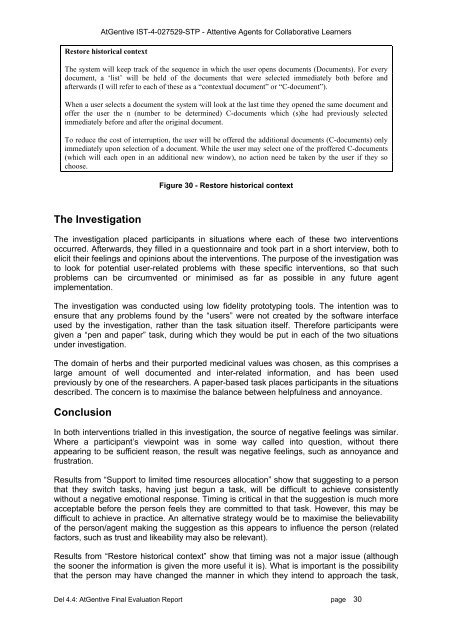Deliverable 4.4 - INSEAD CALT
Deliverable 4.4 - INSEAD CALT
Deliverable 4.4 - INSEAD CALT
You also want an ePaper? Increase the reach of your titles
YUMPU automatically turns print PDFs into web optimized ePapers that Google loves.
AtGentive IST-4-027529-STP - Attentive Agents for Collaborative LearnersRestore historical contextThe system will keep track of the sequence in which the user opens documents (Documents). For everydocument, a ‘list’ will be held of the documents that were selected immediately both before andafterwards (I will refer to each of these as a “contextual document” or “C-document”).When a user selects a document the system will look at the last time they opened the same document andoffer the user the n (number to be determined) C-documents which (s)he had previously selectedimmediately before and after the original document.To reduce the cost of interruption, the user will be offered the additional documents (C-documents) onlyimmediately upon selection of a document. While the user may select one of the proffered C-documents(which will each open in an additional new window), no action need be taken by the user if they sochoose.Figure 30 - Restore historical contextThe InvestigationThe investigation placed participants in situations where each of these two interventionsoccurred. Afterwards, they filled in a questionnaire and took part in a short interview, both toelicit their feelings and opinions about the interventions. The purpose of the investigation wasto look for potential user-related problems with these specific interventions, so that suchproblems can be circumvented or minimised as far as possible in any future agentimplementation.The investigation was conducted using low fidelity prototyping tools. The intention was toensure that any problems found by the “users” were not created by the software interfaceused by the investigation, rather than the task situation itself. Therefore participants weregiven a “pen and paper” task, during which they would be put in each of the two situationsunder investigation.The domain of herbs and their purported medicinal values was chosen, as this comprises alarge amount of well documented and inter-related information, and has been usedpreviously by one of the researchers. A paper-based task places participants in the situationsdescribed. The concern is to maximise the balance between helpfulness and annoyance.ConclusionIn both interventions trialled in this investigation, the source of negative feelings was similar.Where a participant’s viewpoint was in some way called into question, without thereappearing to be sufficient reason, the result was negative feelings, such as annoyance andfrustration.Results from “Support to limited time resources allocation” show that suggesting to a personthat they switch tasks, having just begun a task, will be difficult to achieve consistentlywithout a negative emotional response. Timing is critical in that the suggestion is much moreacceptable before the person feels they are committed to that task. However, this may bedifficult to achieve in practice. An alternative strategy would be to maximise the believabilityof the person/agent making the suggestion as this appears to influence the person (relatedfactors, such as trust and likeability may also be relevant).Results from “Restore historical context” show that timing was not a major issue (althoughthe sooner the information is given the more useful it is). What is important is the possibilitythat the person may have changed the manner in which they intend to approach the task,Del <strong>4.4</strong>: AtGentive Final Evaluation Report page 30
















